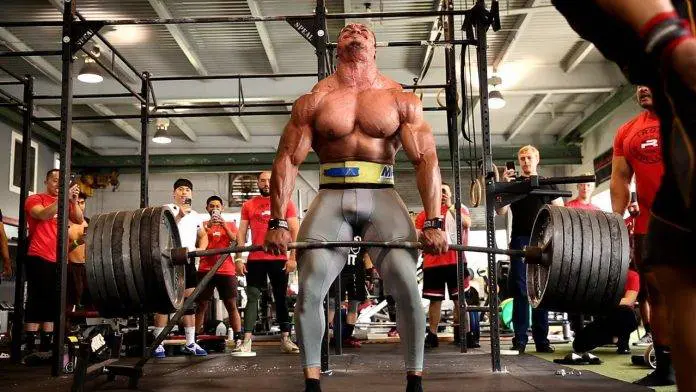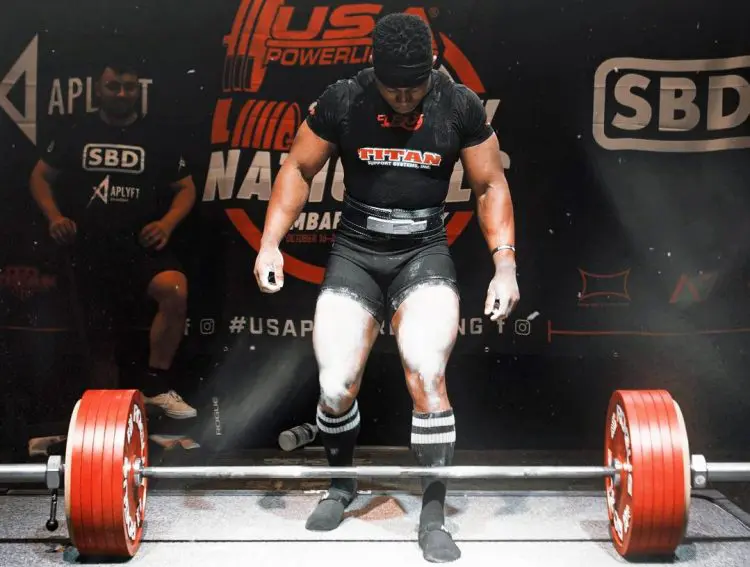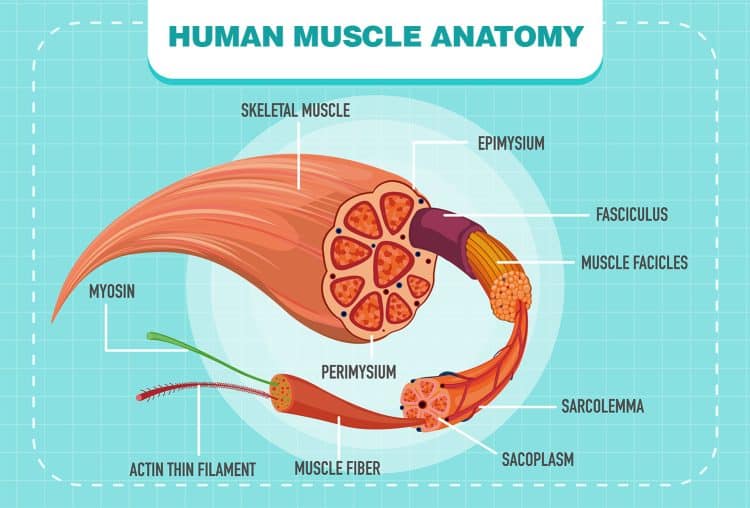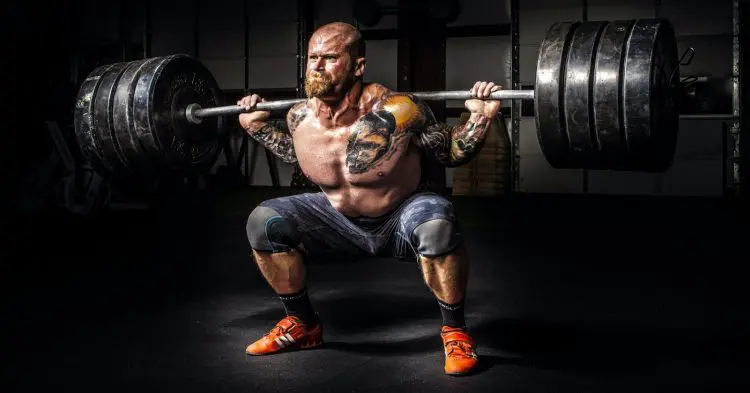Strength sports are gaining popularity. Professional bodybuilding, powerlifting, strongman, weightlifting, and CrossFit shows are witnessing record athlete and fan participation. Strength sports athletes are freaks. Some walk around with 25-inch arms and 30-inch quads; others can deadlift 1,100 pounds.
If you’ve been around the strength sports scene long enough, you’ve probably found yourself in the ‘which athletes are the strongest’ debate. While some use this as an opportunity to claim bragging rights, beginners turn to them for picking the right sport for themselves.
Dense Muscle and Big Soft Muscle Basics
Before diving deeper into the argument, let’s define dense and soft muscles. Powerlifters have dense muscles, and bodybuilders have bigger, softer muscles. Powerlifters will generally be smaller than professional bodybuilders of the same weight class. They can, however, lift heavier than their counterparts.
Athletes that train for strength in the 1-5 rep range have denser (read: thick) muscles than lifters who train for hypertrophy in the 8-12 rep range. [1]

The Strongman and Weightlifter Dilemma
Strongmen and heavyweight powerlifters look bigger and softer than most bodybuilders. Does this mean their muscles are less dense than bodybuilders? On close inspection, you’ll see that strongmen and powerlifters have thick muscles. They hold fat because of a high-calorie diet. Their muscle striations show as soon as they drop their body weight.
According to research, muscle is about 15 percent denser than fat. The density of muscle is about 1.055 g/mL (Ward & Lieber, 2005), and that of fat is about 0.90 g/mL. [2]
Level Up Your Fitness: Join our 💪 strong community in Fitness Volt Newsletter. Get daily inspiration, expert-backed workouts, nutrition tips, the latest in strength sports, and the support you need to reach your goals. Subscribe for free!
Former World’s Strongest Man champions Eddie Hall and Hafþór Björnsson got jacked in a short period for their boxing match. Both strongman contestants had visible abs and thick and dense muscles all over.
Difference Between Dense Muscle and Big Soft Muscle
Muscle size does not promise strength. Weightlifting is an art as much as it is a sport. Moving heavy iron requires skill, technique, and practice. The human body has over 650 skeletal muscles. These muscles include muscle tissue, connective tissue, nerve tissue, and blood or vascular tissue.
Smooth and cardiac are two other types of muscles in the human body. Smooth muscles are present within the hollow internal organs walls such as the bladder, blood vessels, and gastrointestinal tract. Cardiac muscles (or myocardium) comprise the heart’s thick middle layer. Smooth and cardiac muscles are under the autonomic nervous system’s control.
We’ll stick to skeletal muscles in this article as they are responsible for body movement. Skeletal muscles comprise striated muscle fibers that move with conscious or voluntary control. They contract on receiving a signal from a nerve cell impulse.
Types of Skeletal Muscles
Skeletal muscles consist of two types of fibers — fast-twitch and slow-twitch. Each plays a unique role and fires using different techniques. Although your body consists of both these muscle fibers, their ratio can change depending on your age and training routine.
Fast-Twitch Muscle Fibers
These muscle fibers produce explosive power and mobilize during high-intensity activities like HIIT workouts and powerlifting. Since these muscle fibers activate during high-intensity exercises, they burn stored glycogen for energy.
Although fast-twitch muscle fibers are larger than their counterparts, they tire quickly because of their anaerobic characteristics. Plus, they have fewer capillaries, mitochondria, and myoglobin.
Fast-twitch muscle fibers have less blood supply than slow-twitch fibers and are sometimes called type II or white fibers. Type IIX and Type IIA are two sub-categories of fast-twitch muscle fibers. Type IIA, also known as intermediate muscle fibers, is a combination of Type IIX and slow-twitch muscle fibers. As a result, Type IIA can use both anaerobic and aerobic energy, making them have a higher endurance than Type IIX.
Slow-Twitch Muscle Fibers
Slow-twitch muscle fibers use oxygen as fuel, helping them sustain extended physical activities. They are smaller in size and have more blood supply than fast-twitch muscles. They are also called type I or red fibers.
Slow-twitch muscle fibers activate during training for hypertrophy and long-distance endurance activities such as running a marathon. Although they do not generate explosive force, they are crucial for stability and postural control.
While we have a mix of both types of muscle fibers, we can change their ratio by engaging more frequently in activities that activate a particular type of muscle fibers. For example, you should use low-intensity steady-state cardio to increase your slow-twitch muscle fiber ratio. Also, fast-twitch muscle fibers make way for slow-twitch fibers as we grow older. [3]
You might have heard coaches recommend lifting weights using a slow and controlled motion to build muscle. Contrary to what most people think, it is not bro science. Lifting with a slow rep tempo engages your slow-twitch muscle fibers, which is optimal for inducing hypertrophy.
Types of Muscle Growth
Lifting weights and following a balanced recovery program help build muscle mass. All muscle growth, however, is not the same. There are two main types of muscle growth:
Myofibrillar Growth
Myofibrillar muscle growth involves increasing muscle fiber thickness or the number of myofibers. Thicker and greater muscle fibers result in improved strength, meaning you can move bigger weights.
Although myofibrillar growth doesn’t result in bigger muscles, your muscle density and thickness will improve. You will see muscle striations and separation, given your body fat percentage is below 15 percent.
Powerlifters, strongmen, and weightlifters experience this type of muscle growth through their training. Train in the 1-6 rep range to induce myofibrillar growth.
Since myofibrillar growth helps develop thicker muscle fibers, you won’t experience a sudden drop in size if you take a few days off training.
Sarcoplasmic Growth
Sarcoplasmic growth includes increasing sarcoplasm (a fluid that surrounds the myofibrils in the muscles) volume within existing muscle fibers. It results in bigger and fuller muscles but does not increase strength.
The sarcoplasm bump causes the pump during training. The pump makes your muscles look big but does not make you stronger. On the flip side, a muscle-ripping pump can hamper your performance by making the exercises uncomfortable and the pain unbearable.
Since a fluid surrounds your muscle fibers, sarcoplasmic growth draws back your muscle density and hardness. While muscle fibers can contract, sarcoplasm cannot. It reduces the hardness of your muscles.
Sarcoplasmic hypertrophy is why bodybuilders have big muscles but cannot lift as heavy as a powerlifter in their weight class. [4]
As sarcoplasmic hypertrophy builds up fluid in your muscles, you’ll experience muscle deflation after stopping training for a few days. Bodybuilders are pump chasers because they need sarcoplasm fluid retention for muscle maintenance.
What is Dense Muscle?
Dense muscle refers to a greater muscle fiber growth with the muscle than the amount of fatty tissue. You can achieve dense muscle mass and improve your strength by training for myofibrillar hypertrophy. Powerlifters train in the rep and set range optimal for myofibrillar growth.
How To Train For Dense Muscle
You should train like a powerlifter to build muscle density. Here are a few tips to make the most of your program:
Low Reps and Big Weights

Lift heavy weights to build dense muscle as it activates all muscle motor units. Stay above 85 percent of your one-rep max to maximize building strength and muscle thickness. Motor until activation during lifting improves as you gain experience and develop muscle memory.
Anaerobic training helps build muscle density. Perform 1-6 explosive reps in each set to build strength. Go as heavy as possible while maintaining proper form. Lifting near your 1RM will limit the number of reps you can do. If you can complete six reps of an exercise with good form, it is a sign that you have grown stronger and should bump up the weight.
Sticking to lighter weights can hamper your results as the resistance can only fire some motor units. You must lift heavy to stimulate your highest-threshold motor units and force synchronous motor unit activity.
Lifting heavy increases your odds of injury. Ensure you have a spotter while training close to your one-rep max.
Perform Compound Exercises
Make compound (multi-joint) movements the center of your training regimen, and keep your training intensity high. The big three — the squat, bench press, and deadlift — should be the backbone of your workout routine.
Check Out: 6 Powerlifting Strength Training Programs – Beginner to Advanced
Level Up Your Fitness: Join our 💪 strong community in Fitness Volt Newsletter. Get daily inspiration, expert-backed workouts, nutrition tips, the latest in strength sports, and the support you need to reach your goals. Subscribe for free!
Focus on Rest
Rest for 2-5 minutes between each set on a powerlifting program. The relatively longer rest durations help with adenosine triphosphate (ATP) and creatine regeneration in the muscles, which can improve your lifting performance. Allowing your body enough time to recuperate between sets aids in coordinated motor unit activity and maximal motor unit recruitment and can result in lifting bigger weights using better control. [5]
Whether training for strength or size, you must focus on your recovery program. Ensure you sleep between 7-8 hours each night to give your muscles enough time to rest and recuperate.
Incorporate Advanced Training Techniques
Use advanced training principles like supersets, dropsets, and intraset stretching to make the most of your workouts. You should also deploy assistance exercises in your powerlifting routine to avoid hitting plateaus. Advanced training techniques are also an asset for a bodybuilding routine.
Follow a Balanced Diet
You need to follow a nutrition-dense diet for a successful transformation. Determine your daily caloric goals and use an appropriate macro split to work towards your strength and physique goals.
Recommended Training Program
- Load: >85% 1RM
- Reps: <6
- Sets: 2-6
- Rest: 2-5 min
What is Big Muscle?
Big muscle refers to the overall muscle size. Lifters that train for sarcoplasmic hypertrophy will have bigger muscles because of the metabolic stress, sarcoplasm buildup, and the onset of muscle hypertrophy. Bodybuilders training for aesthetics fall into this category. They are generally bigger than powerlifters but cannot lift as heavy.
How To Train For Big Muscles
Many rookies believe lifting super heavy alone can help them build muscle mass. Training for hypertrophy demands a different approach compared to training for building strength.
Stick to these tips to build bigger muscles:
Focus on Muscle Contraction
Unlike a powerlifting program where moving the weight through the full range of motion with proper form is enough, you need to squeeze your muscles at the static contraction points on a bodybuilding program to ensure you are not leaving gains on the table. Pose between sets to flush your muscles with blood and lactic acid to induce hypertrophy.
Protein Degradation
Protein is the building block of muscle. It should explain bodybuilders’ obsession with the macronutrient.
Weight training starts the protein degradation process, which involves muscle tissue breakdown. It puts your muscles in the optimal position to grow back stronger and bigger, given you are following a balanced diet and recovery program.
Protein degradation depends on two factors:
- Poundage: Lifting heavier weights can result in greater muscle breakdown.
- The number of reps: Combining heavier weights with a higher number of reps induces hypertrophy.
Perform 8-12 Reps
Research has proved that performing 8-12 reps in each resistance training exercise is optimal for building muscle mass. Use a weight that makes you hit failure in this rep range [1]. Stay in your one-rep max’s 60-85 percent range to optimize hypertrophy. Lifting heavy for a high number of reps satisfies both protein degradation conditions.
Keep Your Rest Periods Between Sets Short
Limit your rest duration between sets to 30-90 seconds to stay in the muscle-building sweet spot. Also, you should rest at least 48 hours before training the same muscle group again. Hitting the same muscles too soon can lead to overtraining and hitting a plateau.
Follow a Balanced Training Program
Bodybuilders focus on aesthetics. Ensure that you are training all your muscle groups each week and are utilizing all possible angles to streamline hypertrophy. Use unilateral training to fix muscle and strength imbalances.
Recommended Training Program
- Load: 60-85% 1RM
- Reps: 6-12
- Sets: 3-5
- Rest: 30-90 sec
Related: Best Bodybuilding Programs for Beginner, Intermediate, and Advanced Lifters
Dense Muscle vs. Big Soft Muscle Training Program
Given below are a couple of proven training programs that can take you toward your physique goals:
Madcow 5×5 Powerlifting Program For Building Strength
Madcow 5×5 is one of the most popular powerlifting programs to help build dense muscle mass and strength. This powerlifting program involves training three days a week and incorporates a lot of volume and intensity, making it suitable for advanced lifters.
The Madcow 5×5 program includes five exercises — squat, bench press, deadlift, barbell row, and overhead press. You’ll use the pyramid technique in this routine, meaning you lift heavier in every successive workout. Your goal will be to lift five pounds heavier each subsequent week. It is an incredibly effective program to help you break through plateaus.
Madcow 5×5 Schedule:
Monday
- Squat: 5 x 5 reps
- Bench Press: 5 x 5 reps
- Bent-Over Row: 5 x 5 reps
Wednesday
- Squat: 4 x 5 reps (light)
- Overhead Press: 4 x 5 reps
- Deadlift: 4 x 5 reps
Friday
- Squat: 6 x 5/5/5/5/3/8 reps
- Bench Press: 6 x 5/5/5/5/3/8 reps
- Bent-Over Row: 6 x 5/5/5/5/3/8 reps
Madcow 5×5 Progression
The weights you’ll use in this training program will depend on your 5RM. Here is the split for the three training days:
- Monday: 50%, 60%, 70%, 85%, 95%
- Wednesday: 60%, 70%, 85%, 95% (squats are 50%, 60%, 70%, 70%)
- Friday: 50%, 60%, 70%, 85%, 95%, 70%
4-Week Training Program For Building Big Muscles
Below is a four-week full-body training program to help you build muscle mass and conditioning. The five days a week training routine ensures you are training your muscles from different angles for overall development.
This is a high-volume training regimen, and you’ll be doing up to 30 sets. Expect to spend up to two hours in the weight room for some of these workouts. You’ll also build muscle endurance and stamina on this program. Follow this bodybuilding regimen for 12 weeks for optimal results.
Day 1: Chest and Calves
- Treadmill (walk): 10-min
- Decline Bench Press: 5 x 10
- Dumbbell Bench Press: 5 x 8-12
- Pec Deck Fly: 5 x 8-12
- Standing Calf Raise: 3 x 25
- Leg Press Calf Press: 3 x 25
Day 2: Back and Abs
- Stairs: 10-min
- Barbell Bent-Over Row: 5 x 12
- Lat Pulldown: 5 x 8-12
- Bent-Over Dumbbell Row: 5 x 8-10
- Cable Crunch: 3 x 20
- Plank: 3 x 1-minute
Day 3: Biceps and Triceps
- Treadmill (walk): 10 mins
- Barbell Bicep Curl: 4 x 10-12
- Machine Preacher Curl: 3 x 10
- Bicep Hammer Curl: 3 x 10
- Rope Pressdown: 4 x 10-12
- Overhead Dumbbell Tricep Extension: 3 x 10
- EZ Bar Skull Crusher: 3 x 10
Day 4: Legs and Abs
- Stairs: 10-min
- Squat: 5 x 10
- Leg Press: 5 x 8-12
- Leg Extension: 5 x 10-12
- Lying Leg Curl: 3 x 8-12
- Romanian Deadlift: 3 x 8-10
- Good Morning: 3 x 8-12
- Hanging Leg Raise: 3 x 20
- Crunch: 2 x 20
Day 5: Shoulders and Calves
- Smith Machine Shoulder Press: 4 x 12
- Dumbbell Upright Row: 3 x 8-12
- Dumbbell Lateral Raise: 3 x 10
- Reverse Pec Deck Fly: 3 x 10-12
- Seated Calf Raise: 10 x 10
- Smith Machine Calf Raise: 5 x 15
Can You Combine Dense and Big Muscles?
Many lifters want the best of both worlds. They want the thick, dense muscles of a powerlifter that they can flaunt on a bodybuilding stage. But is this possible?
Yes, you can build big, dense muscles, and many athletes have achieved the feat. Mike O’Hearn, Stan Efferding, and Johnnie Jackson are a few athletes that have rocked both powerlifting and bodybuilding stages.
Drawbacks of Training For Dense and Big Muscles
Many people wonder if crafting big, dense muscles is possible; why would anyone stick to just one? Here are a few reasons for the same:
Imbalance
Powerlifters mainly focus on three lifts — the squat, bench press, and deadlift. Using progressive overload techniques on these lifts develops the primary target muscles like the quads, the chest, and the back. You will notice improved density and muscle size with time. Sticking to these lifts, however, leads to an imbalance between the target muscles of the big three and secondary muscles like the biceps, shoulders, triceps, hamstrings, and calves.
Mediocrity
Since powerlifting and bodybuilding both include lifting weights, many assume they can juggle the two simultaneously. You could switch between training plans focusing on myofibrillar and sarcoplasmic hypertrophy but expect mediocre results at best.
Here is some info that might put things into perspective. No professional bodybuilder holds a powerlifting world record in any weight class. On the flip side, no pro powerlifter has won a top bodybuilding show.
Champion-caliber physiques are built by determining your goal and sticking to the appropriate training program.
Increased Risk of Injury
Bodybuilders lift moderate weights for a high number of reps. Powerlifters lift close to their 1RM for fewer reps. Bodybuilding and powerlifting require different lifting techniques. Lifting super-heavy using a bodybuilding method and vice-versa can increase your odds of injury.
Switching between these training programs requires you to unlearn and re-learn lifting techniques. Managing both lifting techniques is possible but demands dedication and patience. Some enjoy switching between training programs; others find it a waste of time.
Can You Train For Both?
Training for myofibrillar and sarcoplasmic hypertrophy simultaneously is not optimal for folks who want to crack the upper echelons of bodybuilding or powerlifting.
Although power-bodybuilders, as the hybrid athletes are popularly known, have not won any top pro bodybuilding shows or set world records in powerlifting, many have competed at the top level in both sports and earned accolades.
Switch between these programs routinely if you are a hobbyist and train for longevity. Most training regimens, whether powerlifting or bodybuilding, are 12 weeks, which is adequate to see noticeable progress. Switch between these programs to challenge yourself and build big and dense muscles.
Shuffling powerlifting and bodybuilding programs has a few benefits, including:
- Keeps your muscles guessing by switching training intensity, volume, and frequency. It helps avoid a plateau.
- Compound movements can improve mobility and functionality, and isolation exercises can boost your mind-muscle connection.
- Lastly, it helps build muscle density and size by inducing myofibrillar and sarcoplasmic hypertrophy.
FAQs
Should I train for muscle density or size?
It depends on your goals. Some people like powerlifting, while others prefer working on their aesthetics. You could also follow a hybrid training program and switch between powerlifting and bodybuilding workouts every couple weeks.
Are powerlifters stronger than bodybuilders?
Powerlifters, on average, are stronger than bodybuilders in their age and weight class. Powerlifters concentrate on lifting heavy while bodybuilders focus on building muscle mass, symmetry, balance, and conditioning.
How much time does it take to build muscle size and density?
Give yourself at least 12 weeks to see noticeable progress. The timeline, however, can change depending on your starting shape and objectives.
Wrapping Up
Building dense muscle requires training for myofibrillar hypertrophy by staying in the 1-6 rep range. It is a form of anaerobic exercise that demands explosive power and helps build strength, muscle density, and thickness.
On the other hand, building big muscles demands sarcoplasmic hypertrophy, which can be achieved through the 8-12 rep range. Streamline your progress by maintaining a balanced training, diet, and recovery program.
References
- Schoenfeld BJ, Grgic J, Van Every DW, Plotkin DL. Loading Recommendations for Muscle Strength, Hypertrophy, and Local Endurance: A Re-Examination of the Repetition Continuum. Sports (Basel). 2021 Feb 22;9(2):32. doi: 10.3390/sports9020032. PMID: 33671664; PMCID: PMC7927075.
- Engelke K, Museyko O, Wang L, Laredo JD. Quantitative analysis of skeletal muscle by computed tomography imaging-State of the art. J Orthop Translat. 2018 Oct 28;15:91-103. doi: 10.1016/j.jot.2018.10.004. PMID: 30533385; PMCID: PMC6260391.
- Jansson E, Esbjörnsson M, Holm I, Jacobs I. Increase in the proportion of fast-twitch muscle fibers by sprint training in males. Acta Physiol Scand. 1990 Nov;140(3):359-63. doi: 10.1111/j.1748-1716.1990.tb09010.x. PMID: 2150579.
- Haun CT, Vann CG, Osburn SC, Mumford PW, Roberson PA, Romero MA, Fox CD, Johnson CA, Parry HA, Kavazis AN, Moon JR, Badisa VLD, Mwashote BM, Ibeanusi V, Young KC, Roberts MD. Muscle fiber hypertrophy in response to 6 weeks of high-volume resistance training in trained young men is largely attributed to sarcoplasmic hypertrophy. PLoS One. 2019 Jun 5;14(6):e0215267. doi: 10.1371/journal.pone.0215267. PMID: 31166954; PMCID: PMC6550381.
- Mangine GT, Hoffman JR, Wang R, Gonzalez AM, Townsend JR, Wells AJ, Jajtner AR, Beyer KS, Boone CH, Miramonti AA, LaMonica MB, Fukuda DH, Ratamess NA, Stout JR. Resistance training intensity and volume affect changes in rate of force development in resistance-trained men. Eur J Appl Physiol. 2016 Dec;116(11-12):2367-2374. doi: 10.1007/s00421-016-3488-6. Epub 2016 Oct 15. PMID: 27744584.










